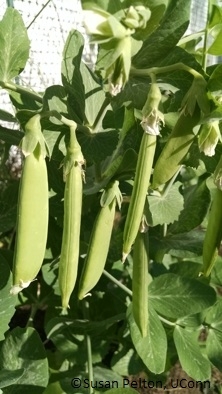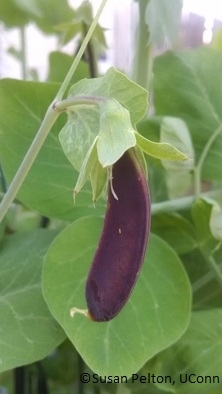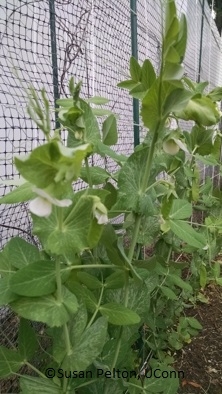Peas
Peas are a cool season annual vegetable plant in the family Fabaceae which also contains legumes and beans. Shelling peas (Pisum arvense) and other legumes that are grown to maturity and dried prior to consumption are known as pulses. Immature peas are generally eaten fresh or lightly cooked and include green garden peas (P. sativum), snow peas and sugar snap peas (P. macrocarpon). Flowers and young shoots can be added to salad for a fresh pea taste although harvesting at this stage will prevent fruit development.

Planting
Pea seeds can be direct sown as soon as the soil becomes workable in the early spring. Pea seed will germinate in soil temperatures as low 50°F although germination will be slow during cool, wet weather. Plantings may be done every two weeks through mid-May to stagger harvesting. Most varieties will reach maturity in 60 days during a growing period where temperatures are in the 55-70° F range. They do not do well in higher temperatures but can be re-sowed for a fall crop 8-10 weeks prior to the first projected frost, usually early to mid-October in Connecticut.
Peas should be planted in full sun or light shade, 1-2” deep (shallow if the soil is cool and wet, deeper if the soil is dry) and 1-4” apart in rows 12” apart. Cover and pat the soil. Fertile, well-drained, sandy soil is best for early plantings while finer-textured soils that retain more moisture can be used for late spring crops. Soil pH should be in the 6.0-6.8 range.
Fertilizer Requirements
Peas are nitrogen-fixing plants meaning that they can obtain or ‘fix’ a portion of the nitrogen that they need from the atmosphere. The fixing is done by the soil-borne bacterium Rhizobium leguminosarum that forms nodules on the roots. When the current crop of pea plants is left to decompose after harvesting then nitrogen will be returned to the soil for the next year’s crop. Seed inoculated with Rhizobium leguminosarum is commercially available but is only needed when peas have not been grown on a site previously. Pea plants that are given nitrogen fertilizer will have lots of foliar growth but less fruit production. A soil test from the UConn Soil Nutrient Analysis Laboratory will provide recommendations for phosphorus, potassium and micro-nutrients along with a pH reading.
Care
Peas require one inch of water per week which they generally receive with spring rains. Mulch 3-4” with dried grass clippings, weed-free straw or other organic material to keep the soil moist and prevent water loss and suppress weeds.
Harvesting
Shelling peas can be shelled immediately or cooled for shelling later. To cool, immerse them in very cold water until chilled, then dry and refrigerate. Once cooled, they will hold their quality for more than a week in the refrigerator. Green garden peas, snow peas, and sugar snap peas are at their best when they are picked slightly immaturely and eaten soon after harvest. Like sweet corn, green garden peas turn starchy quickly once they have been picked. Edible pod varieties can be stored up to 2 weeks in the refrigerator. The pods of garden peas will appear round and swollen when ready. Pick a few each day to determine the best time to harvest. Snow pea pods will still be flat but have BB-sized peas visible. Sugar snaps will have fattened pods, small peas, and will ‘snap’ when broken in two.


Dwarf or bush varieties produce a determinate number of flowers/fruit and set their crops all at once for a single harvest. Taller, indeterminate varieties will do well to be allowed to climb poles, fences, or trellises. Climbing vines are easier to harvest and will bear fruit over a longer period. Pods that are closer to the ground will mature first and all should be picked every 2-3 days.

Diseases and Pests
Contact the UConn Home & Garden Education Center or the UConn Plant Diagnostic Laboratory for confirmation of diseases and pests.
Bacterial Diseases
Bacterial blight is a disease caused by the bacterium Pseudomonas syringae pv. pisi. Plant commercially grown disease-free seed, do not save seed from infected plants, even if pods appeared healthy. If bacterial blight occurs, remove and discard all debris in the fall. Rotate crops if possible. Do not overhead water, harvest or work in the garden while leaves are wet.
Fungal Diseases
Ascochyta blight is a disease complex involving three fungi, Ascochyta pisi, Phoma medicaginis var. pinodella (A. pinodella), and Mycosphaerella pinodes (A. pinodes). These fungi survive winter in plant debris or enter the garden on infected pea seeds. Spores produced in the spring are rain-splashed or windblown to healthy plants causing blackening of the stem from the soil line to a height of 6”. Plants exhibit yellow foliage, brown spots on leaves and stems, and bud drop. Pods and seeds can also be infected. Remove and dispose of infected plants as soon as the disease appears and the remainder of the plants after harvest. Rotate peas with non-susceptible crops yearly. Currently there are no resistant cultivars and no registered fungicides for Ascochyta blight. Use commercially grown disease-free seed.
Rhizoctonia solani, Pythium sp., Fusarium sp., and Aphanomyces euteiches are wilt and root-rot diseases are evident in yellowing and wilting of lower leaves, stunted plant growth, and brown, black, or red mushy stems. Well-drained soils and early-planted, resistant varieties will lessen the possibility of wilts.
Powdery mildew resistant varieties are best for fall planting. If seedling decay, wilt, or root rot have been issues in the past plant in a new location or improve soil drainage.
Insects
Aphids: These are small, light green, soft-bodied insects that use sucking and piercing mouthparts to remove sap from tender growing tips and may spread to the rest of the plant. Aphids rarely damage pods but they may vector one of the viruses that can affect peas. If their numbers become large a spray of water or insecticidal soap, or horticultural oil may be used. Scout for Asian lady beetles and their larvae before using an insecticide as they are a natural predator of aphids.
Cutworms: Plants stems are severed near the soil line. Weedy areas may give good cover to cutworms. Baccillus thuringiensis v. kurstaki is a microbial insect control for cutworm.
Despite good cultural practices, pests and diseases at times may appear. Chemical control should be used only after all other methods have failed.
For pesticide information or other questions please call toll free: 877-486-6271.
UConn Home and Garden Education Center, 2017
Issued in furtherance of Cooperative Extension work, Acts of May 8 and June 30, 1914, in cooperation with the U.S. Department of Agriculture, the Dean of the College, Cooperative Extension System, University of Connecticut, Storrs. The Connecticut Cooperative Extension System is an equal opportunity employer and program provider. To file a complaint of discrimination, write USDA, Director, Office of Civil Rights, Room 326-W, Whitten Building, Stop Code 9410, 1400 Independence Avenue, SW, Washington, DC 20250-9410 or call (202) 720-5964.